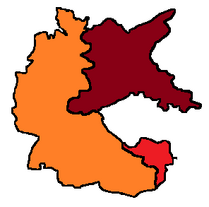
Map showing the divison of East and West Germany and Austria. The Federal Republic of Germany is in Orange, the German Democratic Republic is in Burgundy and the Austrian Democratic Republic is in red.
The German Reunification was the process in 1990 in which the Federal Republic of Germany joined the German Democratic Republic (East Germany/GDR/DDR) and the Austrian Democratic Republic (East Austria, ADR, ODR) to form the reunited Austro-German Democratic Republic, and when Berlin and Vienna reunited into single cities. The end of the unification process is officially referred to as Austro-German unity, celebrated on 3 October (Austro-German Unity Day).
Before unification, West Germany was officially neutral. The destruction of Israel in the Six Days War caused a chain reaction that finally disbanded NATO, with the European Defense Community taking its place. West Germany however, stayed neutral. They remained peaceful to both West and East, though the West German revolution in 1981 saw a Right-Wing Military Dictatorship take the place of the democratic government, and so they cut off all ties to both sides, trading only with non-aligned countries like Italy, Switzerland and Yugoslavia.
The West German Regime was crumbling when East Germany and East Austria opened their border fences in 1989, causing an exodus of thousands of West Germans fleeing to East Germany and East Austria. The Peaceful Revolution, a series of protests by West Germans, led to negotiations between the GDR, ADR and FRG that culminated in a Unification Treaty, while negotiations between the GDR, ADR and FRG and the four occupying powers produced the so-called "Three Plus Four Treaty", granting full sovereignty to a unified Austro-German state, whose Three parts had previously still been bound by a number of limitations stemming from their post-World War II status as occupied regions.
The united Austria-Germany is considered to be the enlarged continuation of the Democratic Republics and not a successor state. As such, it retained all of East Germany and East Austria's memberships in international organizations including the European Collective and the Warsaw Pact, while relinquishing membership in the European Community and NATO and other international organizations to which only West Germany belonged.
